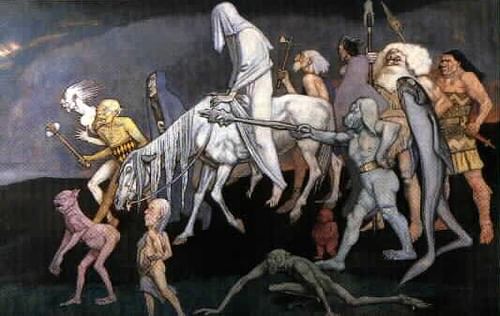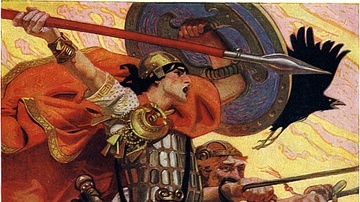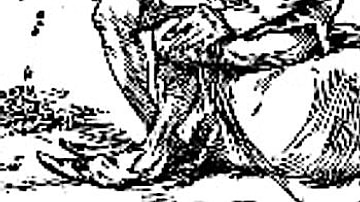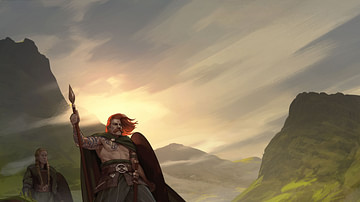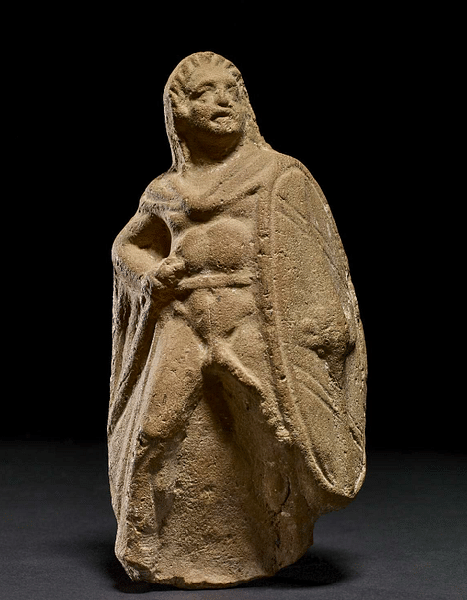
Lugh (also Lug, Luga) was one of the most important Celtic gods, particularly in Ireland, and he represented the sun and light. Although originating as an all-wise and all-seeing deity, Lugh was later thought of as a historical figure, great warrior, and Irish cultural hero. Lugh often has an epithet such as Lugh Lámfada (or Lámfhota), meaning long-armed or 'of the long hand', which refers to his prowess with throwing weapons, or Lugh Samildánach, meaning 'skilled in many arts and crafts'. He is a prominent figure in many stories in Irish mythology where he leads the Tuatha Dé Danann race to victory against the seafaring Fomorians at the Battle of Mag Tuired. Lugh kills one-eyed Balor with his magic spear or sling and so establishes a 40-year reign of peace and prosperity. Lugh is similar in many ways to the Celtic god Lugus, the figure the Romans described as Gaulish Mercury.
Names & Skills
The god Lugh's name means 'light' and 'brightness'. His common epithets are Lugh Samildánach ('skilled in the arts, crafts, and trades') and Lug Lámfada, Lámfhada, Lámhfhada or Lámfhota ('long-armed' or 'long-handed'). The god's most common epithet of 'long-armed' refers to his ability to either throw a spear or a slingshot a very great distance. Not only a great warrior, Lugh may have been considered a fili, that is a seer, diviner, and poet. These multi-skills make Lugh very similar to the deity the Romans described (without giving the indigenous name) as Gaulish Mercury, now known to be called as Lugos or Lugus by the Celts. He is also the equivalent of the Welsh hero Lleu Llaw Gyffes. In art, Lugh is almost always presented as a youthful and handsome athlete, and he often carries his famous spear called Gáe Assail.
Family & Descendants
Lugh is one of the three most important heroes in Irish mythology. His mother is Eithne, the daughter of Balor (aka Balar), leader of the Fomorians (see below) and so he is sometimes called Lug mac Ethnenn. His father is Cian, the son of the healing god Dian Cécht. Lugh was born at the same time as two siblings, but these died shortly after the birth, perhaps explaining Lugh's extraordinary powers as he was, in effect, three people, not one. In another version of the events, the deaths of the other two infants - this time by drowning - is put down to Balor who fears a prophecy that he will be killed by his grandson. However, in yet other versions, Lugh does have a sister, Ébliu.
Lugh's foster mother is Tailtiu, wife of the last Fir Bolg king, Eochaid mac Eirc. In other versions, his foster-mother is the ancient queen Duach. Lugh's foster-father is sometimes Manannán mac Lir, the main Irish-Celtic sea god, who teaches Lugh many skills. Alternatively, his foster-father is Goibniu, the god of smiths and manufacturer of great weapons (including Lugh's mighty spear), or Eochaid, the god of lightning and the horseman of the heavens. The association of all these figures with Lugh explains his many varied powers and skills.
Lugh's wives are variously given as Bui, Nás, Echtach, or Énglic, although in some sources he has all four. The Luigni, an ancient tribe inhabiting what is today County Meath and County Sligo in the north of Ireland, considered themselves descendants of Lugh, even if in many sources he has no children. When he does have a son, it is Cú Chulainn, the great hero of the epic Ulster Cycle, whose mother is Deichtine. Deichtine either swallows a miniaturised version of Lugh while drinking a cup of water or dreams of the god so that she miraculously becomes pregnant with Cú Chulainn. Finally, Lugh has s a faithful dog, Failinis.
The Tuatha Dé Danann
Lugh is the chief of the pre-Christian Irish gods or supernatural race known as the Tuatha Dé Danann who brought elements of civilization in the Irish Mythological Cycle. Lugh's story principally derives from the Cath Maige Tuired (aka The Battle of Mag Tuired), an 11th-century CE text which collated earlier sources. This text tells the story, before Lugh is born, of the invasion of Ireland by the Tuatha Dé Danann who are victorious against the current inhabitants, the Fir Bolg at Mac Tuired, a plain in Connacht in northwest Ireland. The defeated Fir Bolg then disperse to remote islands and to Scotland.
Another battle at the same place follows 27 years later, this time between the Tuatha Dé Danann and the Fomorians, who are either semi-divine beings or demonic pirates depending on which source one consults. Despite being fierce fighters with a fearsome aspect - they have one arm, one leg, and one eye in some versions - the Fomorians are defeated by the Tuatha Dé Danann. Before the battle, the two groups had been at peace and even intermarried so that Lugh is born the grandson of a Fomorian. It is Lugh who played the decisive role in the Second Battle of Mag Tuired.
First, to become the chief of the Tuatha Dé Danann, Lugh had to present his credentials to the current king, Nuadu, who has a mechanical silver arm which some consider a handicap that makes him unfit to be ruler. Lugh informs the king that he is multi-skilled because he has the capabilities of a carpenter, smith, physician, warrior, sorcerer, and historian, amongst many others. Lugh impresses the court with his strength by throwing a huge flagstone and with his skill at playing the harp. Lugh then defeats Nuadu, and anyone else who cares to play, in a board-game called fidchell - a slightly unfair match since Lugh was credited with inventing it - and so he becomes the king.
In the battle with the Fomorians, Lugh uses his sorcery skills to give his army special weapons and the powers of magic. Lugh's own spear, Gáe Assail, was rather special since it always hit its target and could return to his hand on command. The spear was said to be so fearsome that it had to be kept in a cauldron of water during peacetime lest it set its surroundings aflame.
Lugh ends up fighting his own grandfather, Balor or the Evil Eye. Balor has one huge eye and his eyelid is so heavy that it requires four men to lift it. If enemies ever look directly at the eye, then they are rendered powerless. Lugh uses his mighty sling arm to hit his grandfather in the eye which then turns backwards in his head (or simply falls to the ground). The consequence of this is that the Fomorians become the victims of bad luck and so lose the war. In other versions, Lugh blinds Balor with his spear or lops off his head and puts it on a pole so that the eye shines on the Fomorians and makes them easy to defeat. The Fomorians are then driven back to where they came from: the sea. Lugh goes on to rule his new kingdom for 40 years through which time the cows always give plenty of milk and the harvests are always bountiful.
Death
Lugh is involved in other minor episodes such as his vengeance on the murderers of his father Cian. The killers are Brian, Iuchair, and Iucharba, three sons of Tuireann. Lugh discovers his father's crushed body, and the earth around it tells of his fate and who did this terrible deed. Lugh sets the three killers a series of impossible tasks, and two of them die in a battle while Brian is killed by Lugh. It is from this trio and their great labours that Lugh acquires his magical spear and his dog Failinis.
Lugh then himself becomes the victim of a trio of brothers. Lugh's wife (here unnamed) was once unfaithful with Cermait, son of the Dagda, the great all-embracing warrior god. In his fury, Lugh killed Cermait, but his three divine sons Mac Cuill, Mac Cécht, and Mac Gréine seek revenge. Lugh is hunted down near the hill of Uisnech in central Ireland but escapes only to drown in nearby Loch Lugborta. Lugh's body is recovered, and he is buried beneath a cairn on the shores of the loch. Other versions cite multiple candidates for Lugh's tomb, notably at Newgrange (Brug na Bóinne) in County Meath. The three murdering brothers, meanwhile, divide Ireland between themselves.
Legacy: Lughnasa & Beyond
Lugh gave his name to the important festival held each first day of August in Ireland, Lughnasa (or Lughnasadh). Connected to the beginning of the harvest, the festival was similarly celebrated in other Celtic cultures but went by other names. In the Irish version, Lugh dedicates the festival to his foster-mother Tailtiu as part of her funeral ceremony. Besides celebrating the ripening of grain and maturing of potatoes, the occasion was marked by horse races, weapons contests, and other sports. Adherents often climbed hills where they gathered berries and said prayers.
Lugh's name also lived on in many place names in Europe, especially Roman settlements such as Lugdunum (Lyon) in France and Luguvallium (Carlisle) in the United Kingdom. He was, too, the origin of the name Lugaid, which was adopted by many heroic figures in later Irish history. Such was his wide appeal, Lugh was even adopted by early Christian writers who transformed him into the archangel Michael. Lugh's stature diminished over time until he was eventually transformed into Lugh-chromain, meaning 'stooping Lugh' as he now inhabited the underground world of sidh where all the other gods were relegated to as the people forgot their traditions and embraced new religions. From there, Lugh became 'leprechaun', the diminutive fairy-goblin who guards hidden treasure in Irish folklore.
